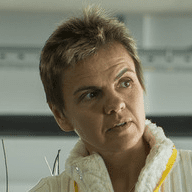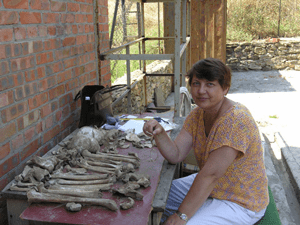TDC member Julie Jurgens interviews Computational Biologist and Ancient DNA Researcher, Tatiana Tatarinova
August 2016

I have always been fascinated by human history and its puzzling nature. For the longest time, I wanted to participate in a project that solves these historic mysteries. That chance came when I met several bright individuals who research ancient DNA (aDNA), such as Alexander Mikheyev from the Okinawa Institute of Science and Technology (OIST) in Japan. In 2015, we organized an Ancient DNA Symposium at the OIST and started collaborating on a range of projects. Allow me to tell you about one of them:
A mysterious Khazarian empire existed approximately between the 7th and 11th centuries and then vanished abruptly, leaving only anecdotal evidence across written history. Khazaria once commanded the western marches of the Silk Road and forged commercial linkages among China, the Middle East, and Europe. However, ancient Khazaria is poorly studied, since written documentation is scarce and heavily biased. Knowledge of the racial and ethnic origins of the Khazars is rooted in legend. There are numerous unanswered questions about their relationships with other populations. Understanding the story of Khazars will shed light on early medieval European history and the fate of people who once were a part of Khazaria.
We are currently working with archaeologists from Rostov University in Russia (Dr. Elena Batieva and her team), who have identified over 300 burial mounds of Khazars. The mounds appeared suddenly along the lower Don River without any obvious precursors in the region. The accepted hypothesis for this sudden appearance is that migrants from Central Asia moved to the Don region in the 7th century and brought their funerary rites and other customs to Southeastern Europe. However, it is difficult to test this hypothesis without DNA evidence. We are using modern DNA analysis to determine the provenance of Khazars, answer questions about their population structure and genetic makeup, and determine the percentage of Khazarian DNA in modern populations.

(Courtesy Dr. Tatarinova)
Our collaborators from Rostov University in Russia and from the Institute of Evolutionary Medicine University of Zurich have tested Khazarian samples and confirmed there are sufficient amounts of human DNA for analysis. The study of aDNA is complicated by its degradation and by bacterial contamination (often >99%), which frequently makes shotgun sequencing impractical. Our collaborator, Dr. Mikheyev, is developing a novel method to selectively capture and amplify human DNA from archaeological samples. His group is currently using the Gansauge and Meyer approach for library construction (2014, “Selective enrichment of damaged DNA molecules for ancient genome sequencing.” Genome Res. 24(9):1543-9).
However, since whole-genome sequencing is too costly for large numbers of samples, they are also experimenting with sequence-specific capture methods. Dr. Mikheyev’s proposed technique will decrease the price of high-resolution genome resequencing to only a few hundred dollars per sample, enabling us to process more population-level data. This chemistry can also be integrated into a microfluidic chip, making it easy to use by other researchers and ultimately paving the way to a genetic map of the ancient world.
I am a computational scientist, so much of what I do relates to coordinating sample collection and experimental work with archaeologists and biologists. After obtaining sequence data, we spend hours validating the data, removing contamination, and pre-processing the data before conducting additional analysis (described in our review). The most challenging part of aDNA research is ensuring data quality. Due to the small size of aDNA fragments and high level of contamination, it is tempting not to enforce strict quality cut-offs. However, if you don’t, it leads down a dangerous path: you end up analyzing junk. Deciding to discard sequencing reads that were either paid for by your small research budget or painfully obtained by collaborators and processed for months is a very hard but necessary step.
Despite these challenges, aDNA analysis is on the cutting edge of research. New tools and methods are being developed constantly, and this makes the field dynamic and exciting. I think aDNA research is headed toward population-level analyses of the evolution of diseases and the co-evolution between hosts and pathogens. For example, aDNA research will be able to examine how an isolated population has adapted to pathogens using longitudinal DNA samples from local graves. This analysis will be supported by technological advances in PCR-free methods, decreased costs, improved sequencing accuracy, and advancements in epigenetic studies of aDNA.
In addition to developing skills in statistics and molecular biology, I would recommend that trainees interested in aDNA read history books and papers to be able to interpret their findings in a historic context. Always remember that collaboration with historians, linguists, paleontologists and archaeologists is essential; try to make friends with them as early as possible. Reconstruction of human history is an extremely multi-dimensional problem. Each specialist holds the key to only one dimension, to a portion of the knowledge. But together, they can generate a hypothesis which can be tested by the statistical analysis of aDNA.
